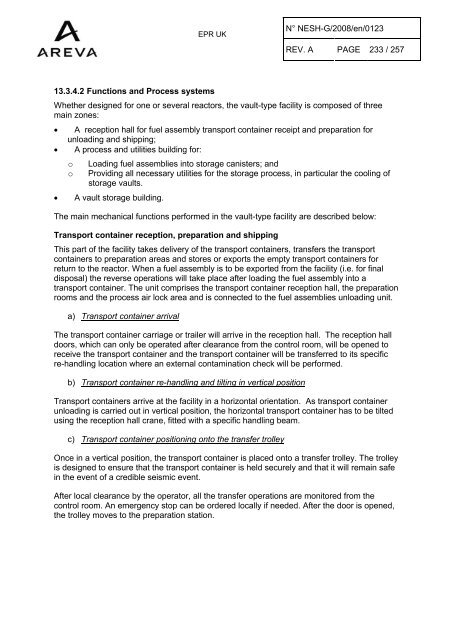Solid Radioactive Waste Strategy Report.pdf - UK EPR
Solid Radioactive Waste Strategy Report.pdf - UK EPR
Solid Radioactive Waste Strategy Report.pdf - UK EPR
Create successful ePaper yourself
Turn your PDF publications into a flip-book with our unique Google optimized e-Paper software.
<strong>EPR</strong> <strong>UK</strong><br />
N° NESH-G/2008/en/0123<br />
REV. A PAGE 233 / 257<br />
13.3.4.2 Functions and Process systems<br />
Whether designed for one or several reactors, the vault-type facility is composed of three<br />
main zones:<br />
· A reception hall for fuel assembly transport container receipt and preparation for<br />
unloading and shipping;<br />
· A process and utilities building for:<br />
o<br />
o<br />
Loading fuel assemblies into storage canisters; and<br />
Providing all necessary utilities for the storage process, in particular the cooling of<br />
storage vaults.<br />
· A vault storage building.<br />
The main mechanical functions performed in the vault-type facility are described below:<br />
Transport container reception, preparation and shipping<br />
This part of the facility takes delivery of the transport containers, transfers the transport<br />
containers to preparation areas and stores or exports the empty transport containers for<br />
return to the reactor. When a fuel assembly is to be exported from the facility (i.e. for final<br />
disposal) the reverse operations will take place after loading the fuel assembly into a<br />
transport container. The unit comprises the transport container reception hall, the preparation<br />
rooms and the process air lock area and is connected to the fuel assemblies unloading unit.<br />
a) Transport container arrival<br />
The transport container carriage or trailer will arrive in the reception hall. The reception hall<br />
doors, which can only be operated after clearance from the control room, will be opened to<br />
receive the transport container and the transport container will be transferred to its specific<br />
re-handling location where an external contamination check will be performed.<br />
b) Transport container re-handling and tilting in vertical position<br />
Transport containers arrive at the facility in a horizontal orientation. As transport container<br />
unloading is carried out in vertical position, the horizontal transport container has to be tilted<br />
using the reception hall crane, fitted with a specific handling beam.<br />
c) Transport container positioning onto the transfer trolley<br />
Once in a vertical position, the transport container is placed onto a transfer trolley. The trolley<br />
is designed to ensure that the transport container is held securely and that it will remain safe<br />
in the event of a credible seismic event.<br />
After local clearance by the operator, all the transfer operations are monitored from the<br />
control room. An emergency stop can be ordered locally if needed. After the door is opened,<br />
the trolley moves to the preparation station.

















